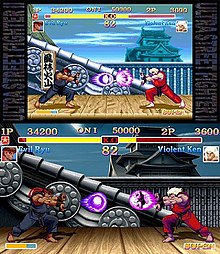Ultra Street Fighter II: The Final Challengers
| Ultra Street Fighter II: The Final Challengers | |
|---|---|
 | |
| Developer(s) | Capcom |
| Publisher(s) | Capcom |
| Series | Street Fighter |
| Platform(s) | Nintendo Switch |
| Release |
|
| Genre(s) | Fighting |
| Mode(s) | Single-player, multiplayer |
Ultra Street Fighter II: The Final Challengers is an upcoming fighting game developed by Capcom for the Nintendo Switch console. It is an updated version of 1994's Super Street Fighter II Turbo. The game features two graphical styles—classic pixel art and updated high-definition art. New gameplay mechanics and modes have been introduced and tweaks have been made to the game's balance.
Gameplay
Ultra Street Fighter II: The Final Challengers is an updated version of the 1991 fighting game Street Fighter II: The World Warrior.[1] Gameplay is based on the Super Street Fighter II Turbo iteration of Street Fighter II, however Ultra Street Fighter II introduces new mechanics like grapple breaks and re-tunes some aspects of the game's balance.[1] Combo timing has also been adjusted from the original games.[2]
The game features local and online multiplayer.[3][4] Online multiplayer includes a point-based ranking system based on a player's wins and loses.[5] A "standby" feature has been added to the game's arcade mode, which allows other online players to challenge and take the place of the CPU opponent that the player typically battles in arcade.[5] A local cooperative game mode, known in the Alpha games as "Dramatic Battle", has been added in Ultra Street Fighter II.[2][6][7] It allows players to team up in a two versus one fight against a CPU player.[2][6][7] Additionally the game includes a simplified one-hit knockout mode.[7]

The game is playable in two graphical styles—the classic pixel art graphics of the original game and updated high-definition graphics similar to 2008's Super Street Fighter II Turbo HD Remix.[6] In the classic art style, the game is played in a 4:3 aspect ratio while in the updated graphics the game is played in 16:9 widescreen.[8] The game supports all control options on the Nintendo Switch console, including play with a single Joy-Con controller.[2]
Ultra Street Fighter II has a roster of nineteen characters.[9] Two characters—Evil Ryu and Violent Ken—have been added to the game's original roster.[6][10] Evil Ryu first appeared in the series in 1996's Street Fighter Alpha 2.[2] He is version of Street Fighter protagonist Ryu that has succumbed to the evil power Satsui no Hado.[6][2] Violent Ken makes his official debut in a Street Fighter game, having previously only appeared in the crossover fighting game SNK vs. Capcom: SVC Chaos.[2][4] He is a version of Ken Masters that has been brainwashed by M. Bison and makes use of Bison's Psycho Powers.[6][2]
Development
Ultra Street Fighter II: The Final Challengers is being developed by Japanese video game company Capcom.[1] The development team is composed of a mixture of old and young employees, some of which worked on recent Capcom fighting games like Street Fighter V and Marvel vs. Capcom: Infinite.[1]
The game was announced for the Nintendo Switch console in January 2017.[6][10] The announcement marked the beginning of Street Fighter's 30th anniversary celebration.[1] With the last Street Fighter title to release on a Nintendo system being 2011's Super Street Fighter IV: 3D Edition for the Nintendo 3DS, Capcom saw the launch of the Nintendo Switch as an opportunity to bring a new Street Fighter game to a Nintendo console.[1]
On the decision to revisit Street Fighter II, series producer Yoshinori Ono noted that they wanted to go back to their roots.[1] Capcom chose to include two graphical styles so that the game would give old players a sense of nostalgia but still appeal to a younger audience with the update art.[1] The game's high-definition graphics were created by Udon Entertainment.[6] The development team did not want to overhaul the game's balance as they want the game to feel like a fighting game from the 1990s.[1] However, they felt that some questionable aspects of the game's balance should be re-tuned.[1]
References
- ^ a b c d e f g h i j k Otero, Jose (20 January 2017). "6 Things We Learned About Ultra Street Fighter II on Nintendo Switch". IGN. Retrieved 21 January 2017.
- ^ a b c d e f g h Bowling, Steve (17 January 2017). "First Impressions: Round One With Ultra Street Fighter II On Nintendo Switch". Nintendo Life. Retrieved 21 January 2017.
- ^ Vazquez, Suriel (14 January 2017). "Capcom Talks Ultra Street Fighter II's New Characters, Gameplay On Nintendo Treehouse Stream". Game Informer. Retrieved 21 January 2017.
- ^ a b Ramos, Jeff (13 January 2017). "Fighting games on the Nintendo Switch will be a complicated affair". Polygon. Retrieved 13 January 2017.
- ^ a b Hussain, Tamoor (12 January 2017). "Ultra Street Fighter 2 Announced for Switch, Has New Characters and Mode". GameSpot. Retrieved 13 January 2017.
- ^ a b c d e f g h Hussain, Tamoor (12 January 2017). "Ultra Street Fighter 2 Announced for Switch, Has New Characters and Mode". GameSpot. Retrieved 13 January 2017.
- ^ a b c McWhertor, Michael (13 January 2017). "Ultra Street Fighter 2 coming to Nintendo Switch". Polygon. Retrieved 13 January 2017.
- ^ Treehouse 2017, 7:45–8:04.
- ^ Ultra Street Fighter II: The Final Challengers – Nintendo Treehouse: Live with Nintendo Switch
- ^ a b Romano, Sal (24 January 2017). "Ultra Street Fighter II details network battles". Gematsu. Retrieved 13 January 2017.
Video
- Ultra Street Fighter II: The Final Challengers – Nintendo Treehouse: Live with Nintendo Switch. YouTube. 20 January 2017. Retrieved 21 January 2017.
